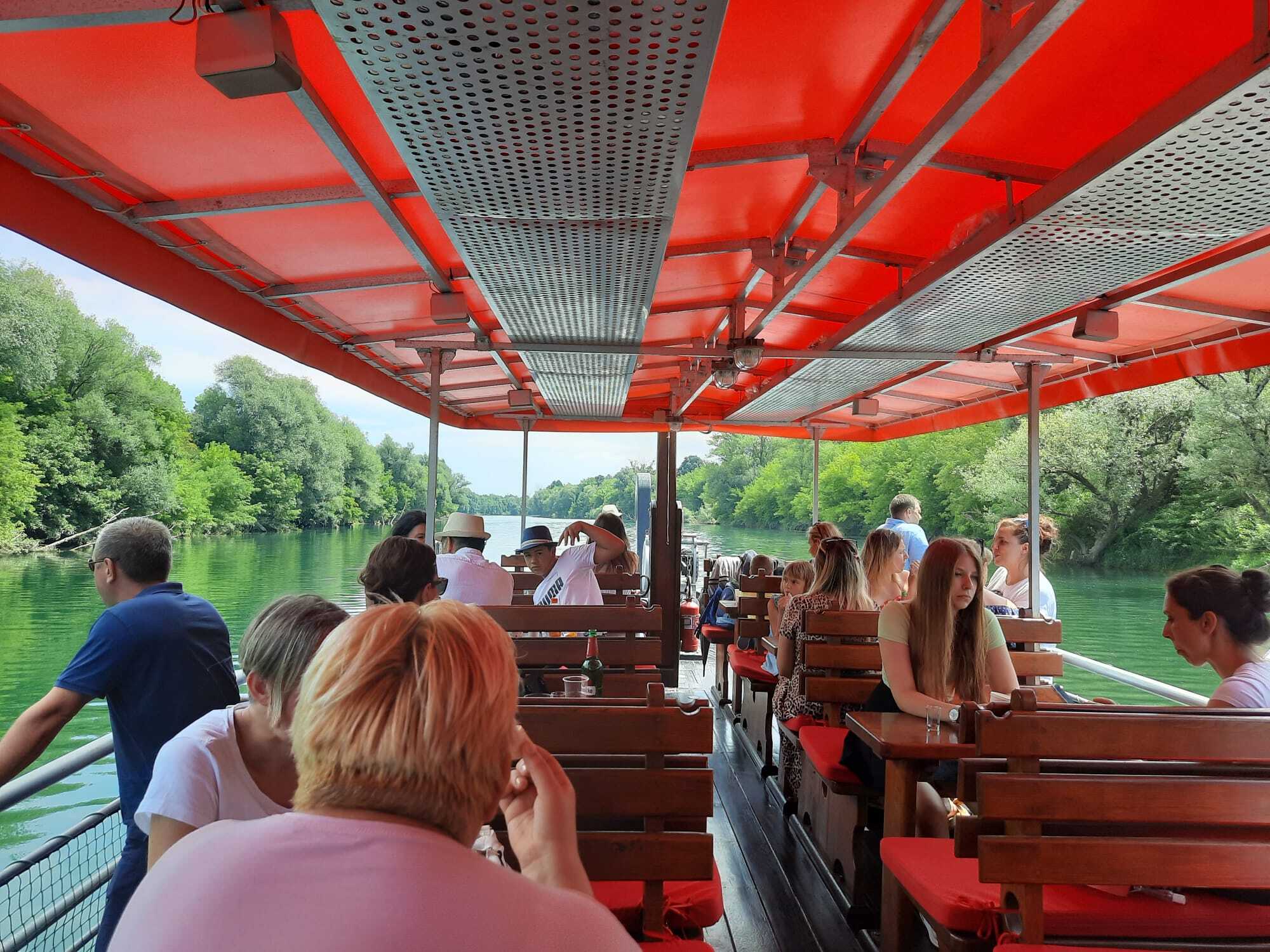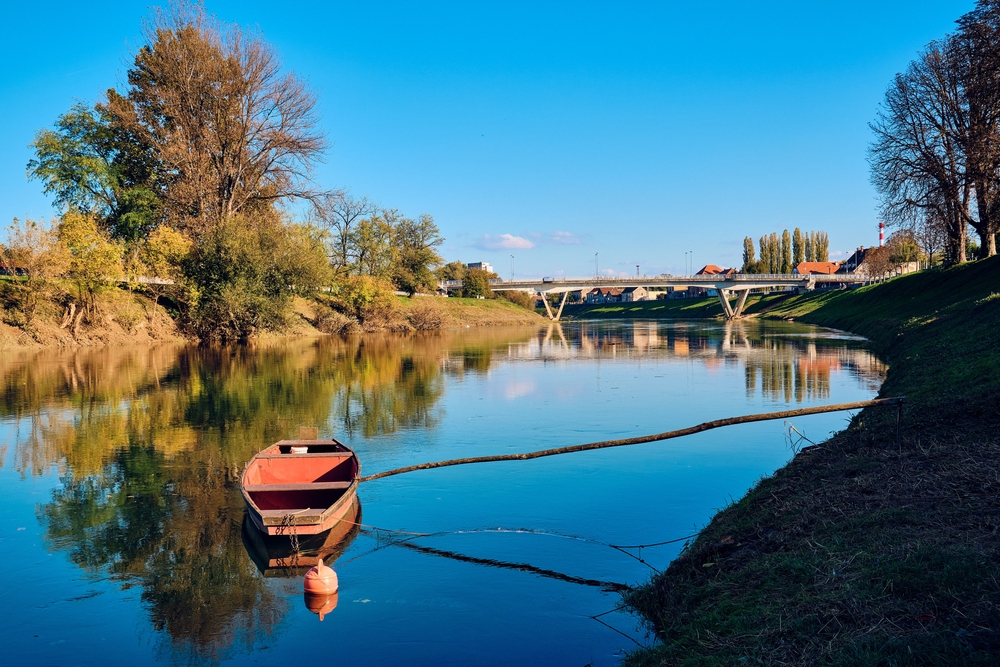
During navigation – photo by Giovanni Vale
Through entrepreneurial initiative, Ana and Jasmina have managed to bring back to life a story – that of river navigation – which involves different territories. The last episode of our report dedicated to the Kupa
(Go to the first, second, and third installments of the report dedicated to the Kupa)
The day we decide to set sail on the Žitna lađa – the historic grain vessel that sailed regularly along the Kupa in the 18th and 19th centuries – a summer storm surprises us just as we embark. It is a hot day in early August in Brođani, a suburb of Karlovac about fifteen kilometres from the centre, and the rain suddenly falls on the bank and on the river, while the sun continues to shine through the clouds. We hurry up and take a seat under the red cloth that protects most of the ship, called Zora, a faithful reproduction of the iconic boat, reborn thanks to the obstinacy of two women. As soon as we sit down, the sky clears up and the navigation begins.
The story of Jasmina and Ana
More than a century has passed since between Karlovac and Sisak the Žitna lađa transported grain, salt, timber, and other goods along the Kupa. The river made it possible to reach the Sava and then the Danube, thus connecting the eastern ports of Serbia and Romania to those located to the west on the Adriatic coast. Between Karlovac and Sisak the wooden boat was pulled by people (and later by horses) along a path drawn on the left bank of the Kupa, while Karlovac was a crucial junction, the point where the river ceased to be navigable and the goods were transferred to the carriages towards the sea.
Today, the path that runs alongside the river is covered by lush vegetation and only a few čamac pass by on the Kupa from time to time, the small flat-bottomed hull typical of fishermen. So what can we do on a 25-metre Žitna lađa? The answer lies in the story of Jasmina Cvetković and Ana Prepolec Padežanin, two friends originally from the area who, after studying in Zagreb, decided to return to the village and to invent a job in order to remain in the places of their childhood. The adventure began in 2008, when Jasmina and Ana decided to rebuild the historical vessel, both to revive the cultural heritage of the area and to create a new tourist attraction between Karlovac and Sisak. Ethnologist Nikolina Belančić Arki, curator at the city museum of Karlovac, immediately helped the two women to identify the ship to be reconstructed, starting from a photograph from the early 20th century that portrays a wooden lađa, anchored in Karlovac near the Banija bridge.
"It took 9 years to go from idea to realisation", recalls Jasmina Cvetković. Initially, the two friends received funding from the Ministry of Tourism to cover the planning phase, which was quickly followed by a contribution from the municipality of Karlovac. The project grew and began to involve various partners, including the municipality of Pokupsko (halfway between Karlovac and Sisak, along the Kupa, as the name suggests), the Development Agency of Republika Srpska, and other associations and local authorities. In fact, Jasmina and Ana's idea became a starting point for revitalising a wider region, that of Kupa-Sava, bringing back to life a story – that of river navigation – which involves different territories.
A few years later, the reconstruction of the Žitna lađa became part of a European project: "The Kupa-Sava grain road", the value of which exceeds 650,000 Euros, approved and financed by the IPA Croatia–Bosnia Herzegovina cross-border programme in the context of the second call for grants. Officially launched in 2013, the project envisaged not only the construction of the boat, designed for around fifty visitors, but also the construction of 2,500 km of cycle paths, various info points and tourist infrastructures, and the printing of maps and programming of a dedicated website. In short, the history of Žitna lađa became a staple of the tourist revival of central Croatia and northern Bosnia.
However, another four years had to pass for the Zora to plow through the waters of the Kupa. The construction process was not easy, starting from the 30 cubic metres of oak needed for the operation. Then there was the problem of transport: the shipyard where the Zora was born is located in Zagreb and you have to take her to Sisak. The operation took place in the spring of 2017. "The transport took place by road, at night and it was necessary to remove many road signs to let the convoy pass", continues Jasmina Cvetković. Getting from Sisak to Brođani, where the ship is anchored today, was another adventure. "We used the last water spring high. The captain called us early in the morning and said 'come to Sisak within two hours, we have to leave immediately!', and we did. Otherwise we would have missed that first summer season”, says Jasmina.
Back on the Zora, sailor and entertainer Dario Olrom questions travellers about the history of the Kupa, sharing anecdotes, legends, and historical facts. "What do you think this mast was for?", Dario asks us, grabbing the tall mast that stands out near the bow of the ship. The passengers look at each other, someone guesses a sail, but the answer is different. "The ropes used by those who towed the lađa were tied here", explains Dario, who then points towards the shore, where once we would have seen the path travelled by this land crew, but which is now covered by vegetation. The trip thus continues between stories and tastings, until at a certain point the route is reversed and we go back to Karlovac.
An earthquake-stricken region
In more than 5 years, the Zora has so far made more than 600 trips, bringing thousands of people to discover a little-known area of Croatia. In fact, Karlovac and Sisak not only share the Kupa, but also a similar history of industrial growth in the 20th century, then accompanied by the involvement on the front lines in the war in the nineties and by the economic crisis that followed the privatisations and the shutdown of many plants. Finally, at the end of 2020, the earthquake also came to shake these lands, in particular towards Sisak and Petrinja, the latter a locality also bordered by our Kupa. More than two years after the earthquake, reconstruction is still struggling.
To date, in fact, barely thirty houses have been rebuilt in the region most affected by the earthquake: the Banovina, located between the Una, Kupa, and Sava rivers and where the cities of Petrinja and Glina are located, among others: thirty houses rebuilt on a total of over 2,000 considered no longer usable in the aftermath of the earthquake. Yet Croatia obtained about one billion Euros in non-repayable funding from the European Solidarity Fund, with the commitment to spend it over a year and a half. That deadline passed and Brussels granted an extension, until 30 June 2023. At the beginning of the year, a report by Al Jazeera Balkans noted that just 37% of the funds had been spent, today the government assures that it is just under 70%. An acceleration which, however, does not substantially change the landscape of the Banovina.
Indeed, the last stretch of the Kupa flows through one of the least developed regions of Croatia, where the GDP per inhabitant is around 8,800 Euros, against approximately 12,500 Euros per inhabitant in Croatia as a whole (or even 21,800 Euros in Zagreb alone, not far away). As far as comparisons based on gross domestic product are valid, it should be considered that the poorest Italian regions have a per capita GDP of more than 17,000 Euros. Here, in this area, the signs of the recession, the war, and the earthquake are apparent, with a general feeling of abandonment by the central government (precisely to respond to accusations like this, at the beginning of 2023, Prime Minister Andrej Plenković replaced Minister Ivan Paladina, in charge of Construction and in charge of reconstruction, with current Minister Branko Bačić).
Among gentle hills, farmland, and dilapidated houses, the Kupa slowly reaches Sisak, a town of about 50,000 inhabitants, much older than Karlovac (it was an important Roman centre, but with previous mentions as well) and whose inhabited centre rises right on the spit of land between the Kupa (west) and the Sava (east), which join slightly to the south. Far from the mountains of Gorski Kotar where it was born, our river is now preparing to continue its journey in the Sava basin, through what has now become the great Pannonian plain. The Sava will mark the border between Croatia and Bosnia and Herzegovina for more than 200 kilometres, before joining the Danube in Belgrade, thus continuing even further east, in a blue ramification that reaches as far as the Black Sea.
This hydrographic network is not only a geographical reality, but also a cultural one. When Jasmina Cvetković and Ana Prepolec Padežanin, supported by ethnologist Nikolina Belančić Arki, met Nikola Brnardić – the naval engineer who later designed the Zora – he first drew a very small lađa. Astonished, the women commented: "But no, we want a bigger lađa, 25 metres long and with a small cabin". "Oh God, you want a tumbas then!", exclaimed the engineer. "But there is no longer a ship like this on the rivers from here to Ukraine!". The wooden boat then became a reality and the little Kupa thus made a great contribution to the family of rivers to which she belongs. Today, those who want to relive the epic of river trade can do so on the Zora .
This content is published in the context of the "Work4Future" project co-financed by the European Union (EU). The EU is in no way responsible for the information or views expressed within the framework of the project. The responsibility for the contents lies solely with OBC Transeuropa. Go to the "Work4Future"







